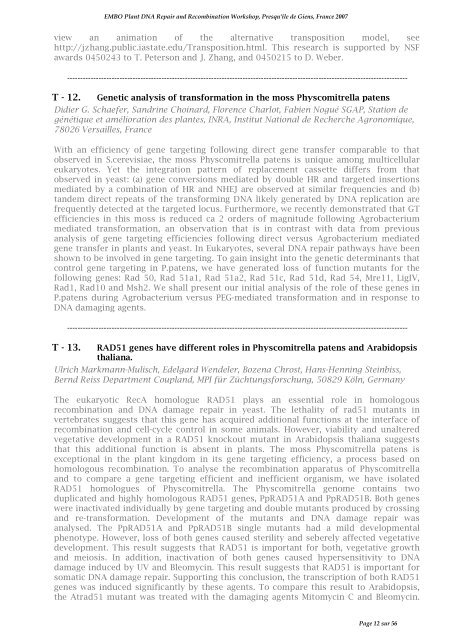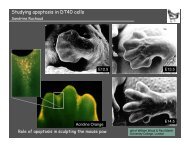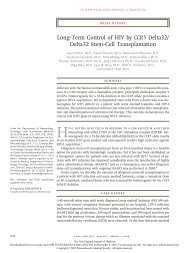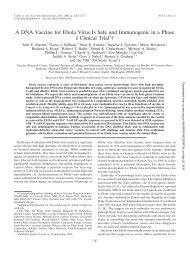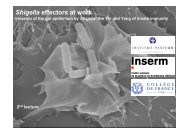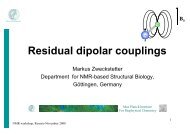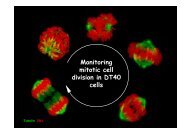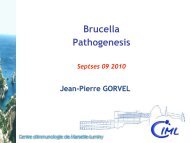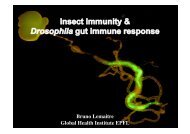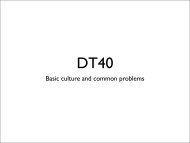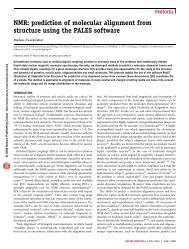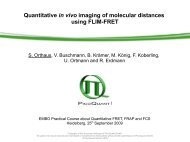pdf file - Events - EMBO
pdf file - Events - EMBO
pdf file - Events - EMBO
Create successful ePaper yourself
Turn your PDF publications into a flip-book with our unique Google optimized e-Paper software.
<strong>EMBO</strong> Plant DNA Repair and Recombination Workshop, Presqu'île de Giens, France 2007<br />
view an animation of the alternative transposition model, see<br />
http://jzhang.public.iastate.edu/Transposition.html. This research is supported by NSF<br />
awards 0450243 to T. Peterson and J. Zhang, and 0450215 to D. Weber.<br />
----------------------------------------------------------------------------------------------------------------------------------<br />
T - 12. Genetic analysis of transformation in the moss Physcomitrella patens<br />
Didier G. Schaefer, Sandrine Choinard, Florence Charlot, Fabien Nogué SGAP, Station de<br />
génétique et amélioration des plantes, INRA, Institut National de Recherche Agronomique,<br />
78026 Versailles, France<br />
With an efficiency of gene targeting following direct gene transfer comparable to that<br />
observed in S.cerevisiae, the moss Physcomitrella patens is unique among multicellular<br />
eukaryotes. Yet the integration pattern of replacement cassette differs from that<br />
observed in yeast: (a) gene conversions mediated by double HR and targeted insertions<br />
mediated by a combination of HR and NHEJ are observed at similar frequencies and (b)<br />
tandem direct repeats of the transforming DNA likely generated by DNA replication are<br />
frequently detected at the targeted locus. Furthermore, we recently demonstrated that GT<br />
efficiencies in this moss is reduced ca 2 orders of magnitude following Agrobacterium<br />
mediated transformation, an observation that is in contrast with data from previous<br />
analysis of gene targeting efficiencies following direct versus Agrobacterium mediated<br />
gene transfer in plants and yeast. In Eukaryotes, several DNA repair pathways have been<br />
shown to be involved in gene targeting. To gain insight into the genetic determinants that<br />
control gene targeting in P.patens, we have generated loss of function mutants for the<br />
following genes: Rad 50, Rad 51a1, Rad 51a2, Rad 51c, Rad 51d, Rad 54, Mre11, LigIV,<br />
Rad1, Rad10 and Msh2. We shall present our initial analysis of the role of these genes in<br />
P.patens during Agrobacterium versus PEG-mediated transformation and in response to<br />
DNA damaging agents.<br />
----------------------------------------------------------------------------------------------------------------------------------<br />
T - 13. RAD51 genes have different roles in Physcomitrella patens and Arabidopsis<br />
thaliana.<br />
Ulrich Markmann-Mulisch, Edelgard Wendeler, Bozena Chrost, Hans-Henning Steinbiss,<br />
Bernd Reiss Department Coupland, MPI für Züchtungsforschung, 50829 Köln, Germany<br />
The eukaryotic RecA homologue RAD51 plays an essential role in homologous<br />
recombination and DNA damage repair in yeast. The lethality of rad51 mutants in<br />
vertebrates suggests that this gene has acquired additional functions at the interface of<br />
recombination and cell-cycle control in some animals. However, viability and unaltered<br />
vegetative development in a RAD51 knockout mutant in Arabidopsis thaliana suggests<br />
that this additional function is absent in plants. The moss Physcomitrella patens is<br />
exceptional in the plant kingdom in its gene targeting efficiency, a process based on<br />
homologous recombination. To analyse the recombination apparatus of Physcomitrella<br />
and to compare a gene targeting efficient and inefficient organism, we have isolated<br />
RAD51 homologues of Physcomitrella. The Physcomitrella genome contains two<br />
duplicated and highly homologous RAD51 genes, PpRAD51A and PpRAD51B. Both genes<br />
were inactivated individually by gene targeting and double mutants produced by crossing<br />
and re-transformation. Development of the mutants and DNA damage repair was<br />
analysed. The PpRAD51A and PpRAD51B single mutants had a mild developmental<br />
phenotype. However, loss of both genes caused sterility and seberely affected vegetative<br />
development. This result suggests that RAD51 is important for both, vegetative growth<br />
and meiosis. In addition, inactivation of both genes caused hypersensitivity to DNA<br />
damage induced by UV and Bleomycin. This result suggests that RAD51 is important for<br />
somatic DNA damage repair. Supporting this conclusion, the transcription of both RAD51<br />
genes was induced significantly by these agents. To compare this result to Arabidopsis,<br />
the Atrad51 mutant was treated with the damaging agents Mitomycin C and Bleomycin.<br />
Page 12 sur 56


